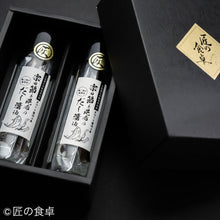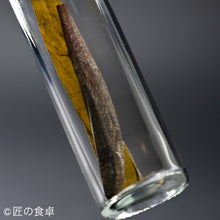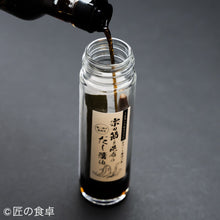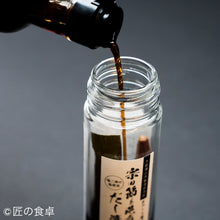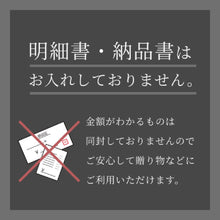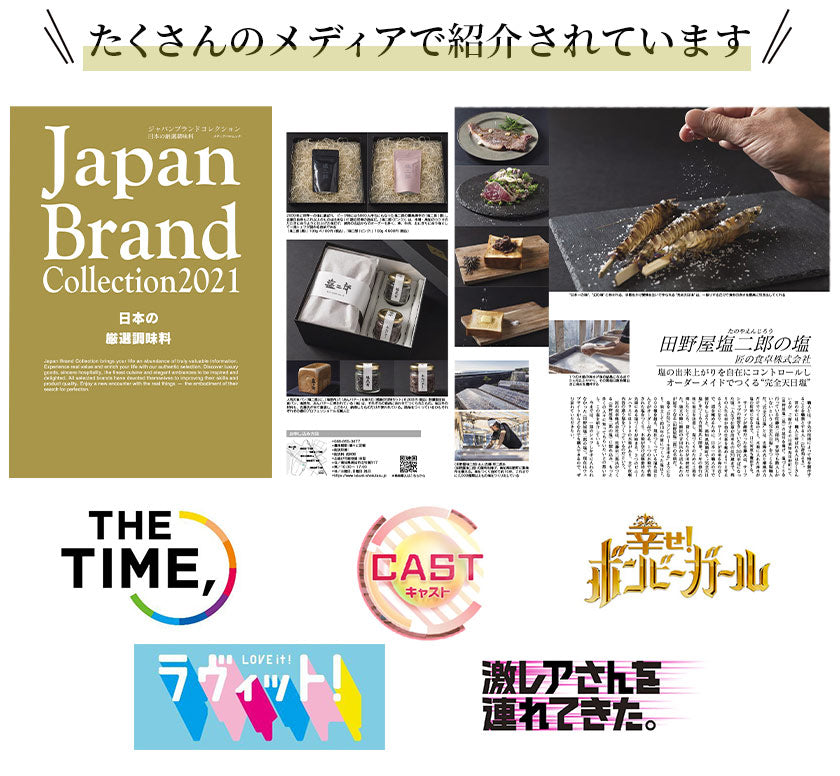Luxurious taste, easy to make.
Soy sauce with dried bonito flakes and kelp

Tosashimizu City, Kochi Prefecture, boasts the highest production of dried bonito flakes in Japan, and the bonito flakes are painstakingly made here, characterized by their rich, deep flavor and full-bodied taste. By using Tanoya Shio Niro's sun-dried salt, which is blessed with the bounty of nature, we have created a bonito flake with even more concentrated flavor. By adding kelp from Hokkaido, you can easily make dashi soy sauce at home that tastes like it comes from a high-end restaurant.
By using fine powder, we can make salt water of the same concentration every time, resulting in a consistent taste. Furthermore, by using Shio Niro's salt water in the manufacturing process, the fishy odor is removed and the umami is greatly enhanced. Unlike ordinary products, after roasting and drying, excess bones and skin are removed with a polishing machine, resulting in the highest quality bonito flakes without any impurities. Polishing creates fine scratches on the bonito flakes, making it easier to extract broth, and combining bonito flakes with kelp, which is a perfect match, further enhances the umami flavor.
The quality of the bonito flakes, which are painstakingly made one by one, depends on experience and intuition. Founded 90 years ago, the company in Tosashimizu City, Kochi Prefecture, continues to work with bonito every day, with the sole aim of "producing the best bonito flakes." This product is recommended for those who are concerned about additives and preservatives, as it allows you to easily enjoy the authentic taste.
If you soak it for a long time, it will develop the characteristic thick consistency of kelp.
Yamaa's Muneta Bushi

Tosashimizu, Kochi Prefecture, the No. 1 producer of dried bonito flakes in Japan
Facing the Pacific Ocean and meeting the Kuroshio Current, Tosashimizu City is one of Japan's leading producers of skipjack tuna (mejika). This fish, the raw material for bonito flakes, loses freshness easily and could only be processed near fishing ports, so everything from landing the fish to making and shipping the flakes has been done in Tosashimizu City. Tosashimizu, where our company is located, is the number one producer of bonito flakes in Japan, accounting for 70-80% of the market share.

Taste, richness and aroma surpassing that of dried bonito flakes
Muneta-bushi is fish flakes made from skipjack tuna (bigeye tuna). When you think of dried fish, you probably think of bonito flakes, but because bigeye tuna has more blood than bonito, it produces a rich broth with a strong aroma, making it a more luxurious type of flake. It is sold for commercial use by Japanese restaurants, long-established soba shops, and food manufacturers, and Muneta-bushi is an essential ingredient in the broth for soba noodles.
The development process of a collaboration product between "Shio Jiro" salt and dried bonito flakes

The collaboration between salt and dried bonito flakes at Shioniro began with research into how to create delicious dried bonito flakes. First, we researched which process would produce the best dried bonito flakes. As salt concentration is also an important factor, we repeatedly made prototypes to find the optimum concentration. As a result, we succeeded in creating the finest dried bonito flakes, packed with the umami of skipjack tuna. Furthermore, by adding kelp, the kelp and dried bonito flakes create a synergistic effect, resulting in a dashi soy sauce that is even more packed with umami.

Fresh bonito is boiled in a pot, the innards and head are removed, and it is split in half. It is then soaked in our original salt water and slowly smoked for about seven days. After smoking, the bonito is sun-dried to bring out the flavor, and then polished. The polished bonito is sterilized and inspected with a metal detector. The bonito is then vacuum-packed with kelp, placed in a boiled bottle, and labeled to complete the product.
For general products, the bonito flakes are roasted and dried, and then excess parts are removed with a knife or other tool to make the product. However, this product is roasted and dried, and then excess bones and skin are removed with a grinder, resulting in the highest quality bonito flakes with no impurities. In addition, grinding creates fine scratches on the bonito flakes, making it easier to extract the broth.
Naniwa Kombukelp

The unique umami and aroma of kelp, which gives a deep flavor to dishes, seeps into the soy sauce, stimulating the appetite.
Naniwa KombuMade with kelp, you can enjoy a dashi soy sauce with a layered dashi flavor that is different from other dashi soy sauces.


Most of the salt sold in Japan is made by boiling seawater that has been mechanically filtered in a cauldron and evaporating it.
EnjiroThis salt is called completely sun-dried salt and is made using only the natural power of sunlight and sea breeze, but there are differences in how sun-dried salt is made.
The most common method is to use a collection tower.
A collection tower is a tower several meters tall with a mesh-like net stretched around the inside.
Seawater pumped up by a pump is sprayed onto the tower, where it falls down through a net and is exposed to the sun and sea breeze as it falls, gradually evaporating. By repeating this process, highly concentrated "brine water" is produced, and most solar salt is made from brine.
EnjiroThere is also a collection tower at the saltworks,EnjiroMost of the time, salt is made without using a salt collection tower.

The reason is that the more steps in salt production are added in order to prioritize efficiency, the more impurities are added and the nutrients contained in the seawater are lost. If you use a salt collection tower, you can make salt in about 1 to 2 months,EnjiroAs you can see, it takes at least three months if you only use sunlight and sea breeze.
Every day, without fail, the seawater contained in the wooden box inside the greenhouse is gently stirred by hand every 1 to 1.5 hours.
It was as gentle as stroking a newborn child.
EnjiroThe salt in seawater andEnjiroThey are obedient children who have been raised with only the love of their parents.
Great gift idea

Simple design that is easy to use in any situation
Package with brand logo embossed on the lid

Box image (size varies depending on the product)
| Product name | Dashi soy sauce base |
|---|---|
| raw materials | Bonito (domestic), kelp (Hokkaido), salt |
| Nutrition Facts | Energy (kcal): 349 Protein (g): 64.9 Fat (g): 6.4 Carbohydrates (g): 4.6 Salt equivalent (g): 1.4 |
| Specific raw materials | none |
| expiry date | 1 year from the date of manufacture |
| preservation method | Refrigerated storage |
| Size (individual size) | Height 17cm, diameter 4cm |
| internal volume | 15g |
| Manufacturer's name | Yamaa Limited Company |
| Manufacturer's residence | Postal Code: 787-0318 Address: 253 Nakahama, Tosashimizu City, Kochi Prefecture |
匠の食卓が選ばれる7つの理由
-
1プロの目利きで選ばれた商品だから
安心の品質 -
2ギフトボックス仕様
※商品により、ギフトボックス仕様ではない場合がございます。 -
3美味しい食べ方レシピ公開中ページはこちら>>
-
4熨斗・メッセージカード対応
※個別メッセージの場合はご注文時にご入力ください。 -
5納品書・明細書・領収書入れません
-
6お届け日指定可能
※受注生産・数量限定品については、ご希望に添えない場合がございます。 -
7
送料込み価格
※お届け先が北海道、沖縄、離島など一部地域のご注文に関しましては別途送料を頂いております。

その他の商品
-
[End of Year Pre-order] Sirloin Steak Set (200g x 2) (Choose from a single steak or a set with salt to go with the meat)
![]()
- 予約販売
- 数量限定
- Regular price
- from 12,600円(税込)
- Sale price
- from 12,600円(税込)
- Regular price
-
- Unit price
- per
Sold out -
【年末予約販売】ローストビーフセット(200g×2個)&タレ(20g×10袋)(単品/肉に合う塩付きセットを選べます)
![]()
- 予約販売
- 数量限定
- Regular price
- from 8,300円(税込)
- Sale price
- from 8,300円(税込)
- Regular price
-
- Unit price
- per
Sold out

![[田野屋塩二郎公式販売サイト]匠の食卓](https://cdn.shopify.com/s/files/1/0509/1200/2215/files/logo.png?v=1618819901)

















